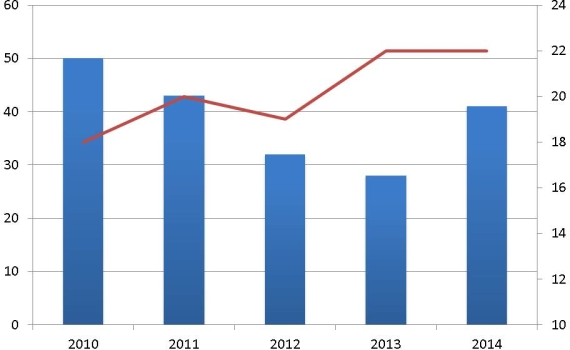Predicting and Reducing 30-Day Readmission After Liver Transplant (OLT).
Transplant Surgery, Cleveland Clinic Foundation, Cleveland, OH.
Meeting: 2016 American Transplant Congress
Abstract number: C215
Keywords: Adverse effects, Liver transplantation, Patient education
Session Information
Session Name: Poster Session C: Liver Transplantation Complications and Other Considerations
Session Type: Poster Session
Date: Monday, June 13, 2016
Session Time: 6:00pm-7:00pm
 Presentation Time: 6:00pm-7:00pm
Presentation Time: 6:00pm-7:00pm
Location: Halls C&D
Background:Reducing early readmissions is a challenge. This study aimed to identify predictors of 30-day readmissions and interventions to minimize readmissions.
Methods: Records of 523 adult OLT recipients from 2010-2014 were retrospectively reviewed. 21 patients (4.1%) were excluded due to early death. Recipient variables were analyzed with attention to indicators of disease severity, location at transplant, previous admissions, functional status and comorbidities. Strategies to reduce readmissions were implemented in 2011 including monthly review of readmissions by the multi-disciplinary team with strategies to avoid readmission, clinic visits within 7 days of discharge, daily communication by coordinators with facilities where patients were discharged, and redirecting non emergency calls to outpatient clinic.
Results:69 % of patients were male with a mean age of 56 ± 10 MELD score was 18.9±9.8 (mean±SD), LOS 12.3±9.16 days, ICU LOS 4±6.7days. 190/502, (37.8%) patients were readmitted within the first 30 days of initial discharge. 61/190(32%) were readmitted within 7 days. The readmission cohort, 190 patients, had a total of 232 readmits in 30 days. 155/190 (82%) patients received a cadaveric graft and 14% were DCDs (n=26). Factors significantly associated with readmission were ICU LOS 5.1±8.6 (p=0.01), LOS 13.9±11.3 days, (p=0.01), Karnofsky score 54.7±21.9 (p=0.032), 28% were hospitalized at the time of transplant (p=0.058), 26% had a history of depression (p=0.023), 68% were admitted to hospital prior to OLT 68% (p=0.056). MELD score or its components did not correlate with readmission rate. Requirement for dialysis approached statistical significance 15% (p=0.082). Annual readmission rates were 50 % in 2010, 43%, 32%, 28% and 41%in 2011, 2012, 2013 and 2014 respectively  . The most common causes for readmissions were infection, renal dysfunction and dehydration.
. The most common causes for readmissions were infection, renal dysfunction and dehydration.
Conclusion: Readmissions were significantly reduced following monthly review and strategic planning. Liver transplant readmissions are unavoidable but it is possible to reduce the rate with a stringent post discharge surveillance program.
CITATION INFORMATION: Eid K, Elshamy M, Louwers L, Eghtesad B, Quintini C, Snyder K, Aucejo F, Hashimoto K, Fujiki M, Miller C, Kelly D. Predicting and Reducing 30-Day Readmission After Liver Transplant (OLT). Am J Transplant. 2016;16 (suppl 3).
To cite this abstract in AMA style:
Eid K, Elshamy M, Louwers L, Eghtesad B, Quintini C, Snyder K, Aucejo F, Hashimoto K, Fujiki M, Miller C, Kelly D. Predicting and Reducing 30-Day Readmission After Liver Transplant (OLT). [abstract]. Am J Transplant. 2016; 16 (suppl 3). https://atcmeetingabstracts.com/abstract/predicting-and-reducing-30-day-readmission-after-liver-transplant-olt/. Accessed December 13, 2025.« Back to 2016 American Transplant Congress
